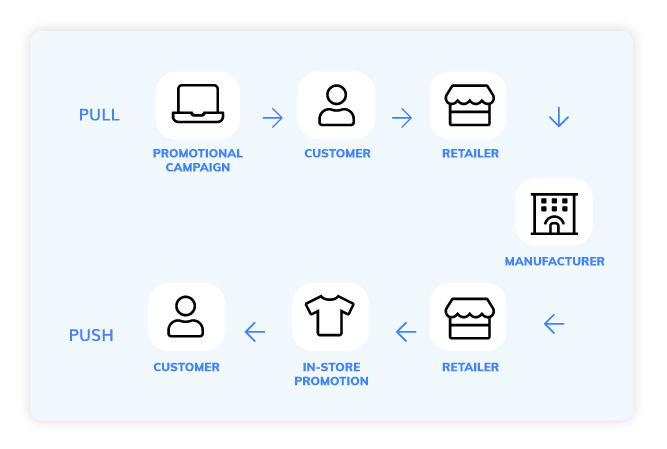[display-name-category]
[post_author]
[wtr-time]
Look around the room. Think about the product that you use most in a day. Maybe it’s your headphones? Perhaps it’s your Netflix account or your Echo Dot? Can you imagine a time before them? It’s hard to do that sometimes once we are completely sold on a product. But there was probably a time when you weren’t as convinced as you are now.
Now, you understand the value that it brings into your personal or business life. Now.
It can be a bit of a walk from Awareness to Purchase. At the beginning of the buyer’s journey, consumers sometimes need a little bit of a push. Brands need to serve their potential customers information to make them aware of their needs and how you can help them satisfy them. A simple push can start an entire journey.
Further down the funnel, brands can switch gears and employ a different approach–pull marketing. You can get consumers to take action by luring them in.
Many businesses continue to think that, depending on their business or industry, it has to be one or the other. This idea is outdated.
Like most dynamics these days, it’s more about balance, understanding both concepts, and knowing when to use them.
The true differentiator isn’t only how but when you approach your consumer. This post will learn how a mix of pull and push marketing can help small to midsize businesses achieve their goals. It’s just a matter of learning how and when to employ these marketing methods.
What is Push Marketing?
The quote above is an excellent example of push marketing. It pushes the product or service to your intended audience. It is an introduction to the unaware consumer, capturing the consumer’s attention while at the venue.
If you are starting and trying to generate awareness, this approach is helpful as it makes your products as visible as possible.
Push marketing can help you:
- Reach a new target audience
- Promote seasonally
- Sell what’s left of the stock
- Launch new products
- Start a new business
- Expand your business
- Improve revenue
Showrooms and displays at venues have been a classic example of push marketing.
If you haven’t guessed it by now, pay-per-click (PPC) advertising is a method of push marketing. As advertisers, we place banners and ads across platforms to increase visibility for a brand. Much like a supermarket display, you’re already there, and we hope to catch your attention as you complete your query.
What is Pull Marketing?
Pull marketing does the opposite. Instead of pushing products on its consumers, it lures customers in to make the purchase.

Pull marketing gets you at the venue, buta business must get creative to incentivize you. This method is less in your face and invites users to make their own decisions. In modern digital terms, users are inspired and asked to “follow” brands. It’s a more organic interaction.
Digital practices that fit this category are search engine optimization (SEO), social media content, and reviews. All of these inspire the user to take action.
Pull marketing can be especially useful when you hope to:
- Increase traffic on social media or website
- Display customer engagement and satisfaction
- Cultivate brand loyalty
- Focus on long-term growth and goals
As mentioned earlier in this post and throughout our blogs, SEO and PPC are the perfect balance of strategies. Combining pull and push is better than just sticking to one.
SEO & PPC Marketing for Small to Midsize Businesses
Now that we understand the principles behind these marketing methods, we can get down to business.
How should you go about it? If you are a Small to midsize business, you need to focus on visibility.
There are established businesses in your industry and market. They most likely have significantly larger budgets and have been pushing brand awareness for some time now.
However, PPC and other online marketing strategies are the digital “ace up your sleeve.” They give you a chance at playing with the big guys.
No matter your budget or size, you have the same opportunity to engage in a conversation with your audience online.
What a smaller business needs to accomplish is strategically using this limited budget.
With PPC ads, you can learn as you go, testing various formats and messaging to see what connects best with your audience. You create awareness of your services.
With SEO, you create organic content and build your case by adding consumer-generated content. You cultivate intrigue and interest, getting them to seek you out.
Final Thoughts
The truth is digital marketing changes overnight. For anyone who is taking care of their budget, it’s important to stay up to date with digital capabilities and features. This way, you won’t limit your options as you strive to reach your goals.
So, what are your goals?
What do you wish to achieve in the next few months?
Where on the buyer’s journey are you hoping to make an impact?
As we proposed in the post above, you can reach your goals by combining PPC marketing and SEO – push and pull marketing. You can aggressively pursue one stage of the funnel while allowing another to grow on its own. It all begins with understanding how they can serve you and testing them out.
Need help doing this? Learn about our PPC management services.





